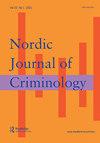Experiencing violence in a cross-media environment: an interdisciplinary focus group study
Q2 Social Sciences
引用次数: 1
Abstract
ABSTRACT Due to drastic changes in the contemporary media environment, criminology needs to examine how the experience of violence is shaped by the emerging cross-media context. We conducted a qualitative focus group study (N = 24) to explore conversations about mediated violence experiences and crime media literacy in Finland, which manifests as an advanced state of cross-media transformation. We found that the cross-media context affects how information on violence and crime is received, as people combine and contrast bits of information from traditional media, social media, alternative media, and direct personal and local knowledge. This constellation of information sources is a fertile ground for distrust, as people challenge the self-regulatory limits of ‘old media’ in reporting on crime and construe such limits as ‘downplaying’ violence. Consistent with the general ‘media-critical’ frame of mind, the interviewees saw crime news media as fear-inducing. Through a focus group of older participants (in addition to three groups of younger participants), we observed generational differences that reflect the dimension of change from the old monolithic media environment to the cross-media context. The new context blurs the distinction between media content and social network-based reception and is thus a game changer for media criminology.在跨媒体环境中经历暴力:一项跨学科焦点小组研究
由于当代媒体环境的剧烈变化,犯罪学需要研究新兴的跨媒体环境如何塑造暴力体验。我们进行了一项定性焦点小组研究(N = 24),以探索芬兰关于中介暴力经历和犯罪媒体素养的对话,芬兰表现为跨媒体转型的先进状态。我们发现,当人们将来自传统媒体、社交媒体、替代媒体以及直接的个人和地方知识的信息进行组合和对比时,跨媒体环境会影响人们对暴力和犯罪信息的接收方式。当人们挑战“旧媒体”在报道犯罪时的自我监管限制,并将这种限制解释为“淡化”暴力时,这种信息来源的组合是不信任的沃土。与一般“批判媒体”的心态一致,受访者认为犯罪新闻媒体会引起恐惧。通过老年参与者的焦点小组(除了三组年轻参与者),我们观察到代际差异反映了从旧的单一媒体环境到跨媒体环境的变化维度。新的背景模糊了媒体内容和基于社交网络的接受之间的区别,因此改变了媒体犯罪学的游戏规则。
本文章由计算机程序翻译,如有差异,请以英文原文为准。
求助全文
约1分钟内获得全文
求助全文

 求助内容:
求助内容: 应助结果提醒方式:
应助结果提醒方式:


